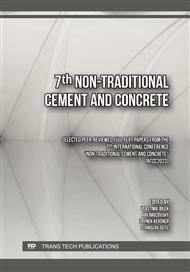p.55
p.69
p.77
p.87
p.97
p.107
p.119
p.131
p.141
Calculating Rheological Properties of Fresh Mortar for Additive Manufacturing Based on Experimental, Multi-Sensor Data
Abstract:
Abstract. Additive manufacturing of concrete structures is a novel and emerging technology. Freecontouring in civil engineering, which allows for entirely new designs, is a significant advantage. Inthe future, lower construction costs are expected with increased construction speeds and decreasingrequired materials and workers. However, architects and civil engineers rely on a certain quality ofexecution to fulfil construction standards. Although several techniques and approaches demonstratethe advantages, quality control during printing is highly challenging and rarely applied. Due to thecontinuous mixing process commonly used in 3D concrete printing, it is impossible to exclude varia-tions in the dry mixture or water content, and a test sample cannot be taken as a representative samplefor the whole structure. Although mortar properties vary only locally, a defect in one layer duringprinting could affect the entire integrity of the whole structure . Therefore, real-time process monitor-ing is required to record and document the printing process.At the Bundesanstalt für Materialforschung und -prüfung (BAM) a new test rig for the additive man-ufacturing of concrete is built. The primary purpose is measuring and monitoring the properties of amortar during the printing process.The following study investigates an approach for calculating yield stress and plastic viscosity based onexperimentally recorded pressure data. The calculations assume that fresh mortar behaves as a Bing-ham fluid and that the Buckingham-Reiner-equation is applicable. A test setup consisting of rigid pipeswith integrated pressure sensors at different positions is utilized.Monitoring the printing process with different sensors is crucial for the quality control of an ongoingprocess.
Info:
Periodical:
Pages:
131-139
Citation:
Online since:
March 2024
Keywords:
Permissions:
Share:
Citation:


